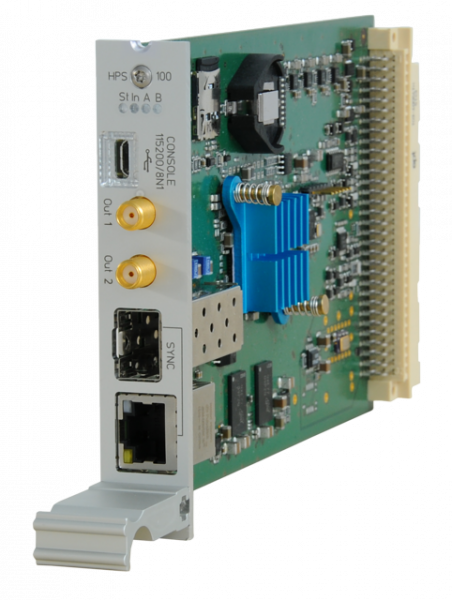Five Minute Facts About Packet Timing
Those of you who know Meinberg may have noticed that Meinberg typically does not talk about licenses. The reason for this is, that Meinberg, in most cases, does not charge you extra for enabling specific features or functions. With our free lifetime support and firmware update policy, you can take advantage of a new feature as soon as you get your free firmware update.
There is one exception. Our High-Performance Synchronization module (HPS100), a line card for the Meinberg IMS platform, offers an unparalleled performance for PTP and NTP applications. Each HPS100 can synchronize up to 2,048 PTP unicast slaves or can support hundreds of thousands of multicast delay requests per second. Using it in hardware NTP mode will allow responding to up to 400,000 NTP requests per second and this with hardware timestamping accuracy.
However, many users do not need such a high message bandwidth, therefore Meinberg offers this module with a selection of performance level (PL) options you can choose from. In other words only those who need the full message handling capacity pay for the additional hardware and firmware resources required to achieve it.
In addition to the number of packets/second or unicast slaves supported, the performance level option also enables or disables specific features on the card.

The HPS100 includes a packet generator with hardware timestamping that can be configured to operate in one of the following data network based modes:
1. PTPv2 (IEEE 1588 v2) – default configuration
2. PTPv1 (IEEE 1588v1)
3. NTP with hardware timestamping (NTP HW)
Additionally, each HPS card can be set up to provide the following services:
– NTP with software timestamping (NTP SW)
– Synchronous Ethernet (SyncE).
These two services are independent from the selected modes listed above.
How to understand this? For example, if you choose PTPv2 (one from the 1 to 4 available hardware modes) the card will operate only in PTPv2 mode, therefore no NTP with HW or SyncMonitoring can run in parallel. That said, you can further choose either you want to use the card as a PTP master or a slave, unicast or multicast communication model and which profile.
After you have chosen one of the hardware modes of operation the card can in parallel run also as an NTP time server with software timestamps. However, for this you must have the V7 firmware on your LANTIME and the 1.41 firmware release on the HPS card, or newer versions as they become available. Once you have done both necessary updates you can use the HPS 100 card as a PTP Grandmaster and in parallel let it respond to NTP requests using software timestamping.
Synchronous Ethernet (SyncE) is another feature which can run in parallel together with the above listed modes. SyncE provides frequency synchronization over Ethernet links. It runs over a physical layer and can support the timing performance by allowing a device to stabilize its clock frequency after power up or reconnecting. It is typically used in combination with PTP to speed up initial synchronization and can ensure improved holdover performance. Using it in a network requires full support for SyncE in every node, i.e. every router and switch has to support it, otherwise the SyncE signal will not reach an end device, and so it cannot make use of it.
To summarize: with your HPS100 you can choose among four main different network modes of operations (PTPv2, PTPv1, NTP with HW timestamping or Sync Monitoring). On top of that you can enable services such as NTP server and / or SyncE.
In the next post I will explain you how to choose the right license model of your HPS100 card with a proper packet bandwidth to sync your network. Stay with me!
If you have more questions, write me at: andreja.jarc@meinberg.de or visit our website.
If you enjoyed this post, or have any questions left, feel free to leave a comment or question below.